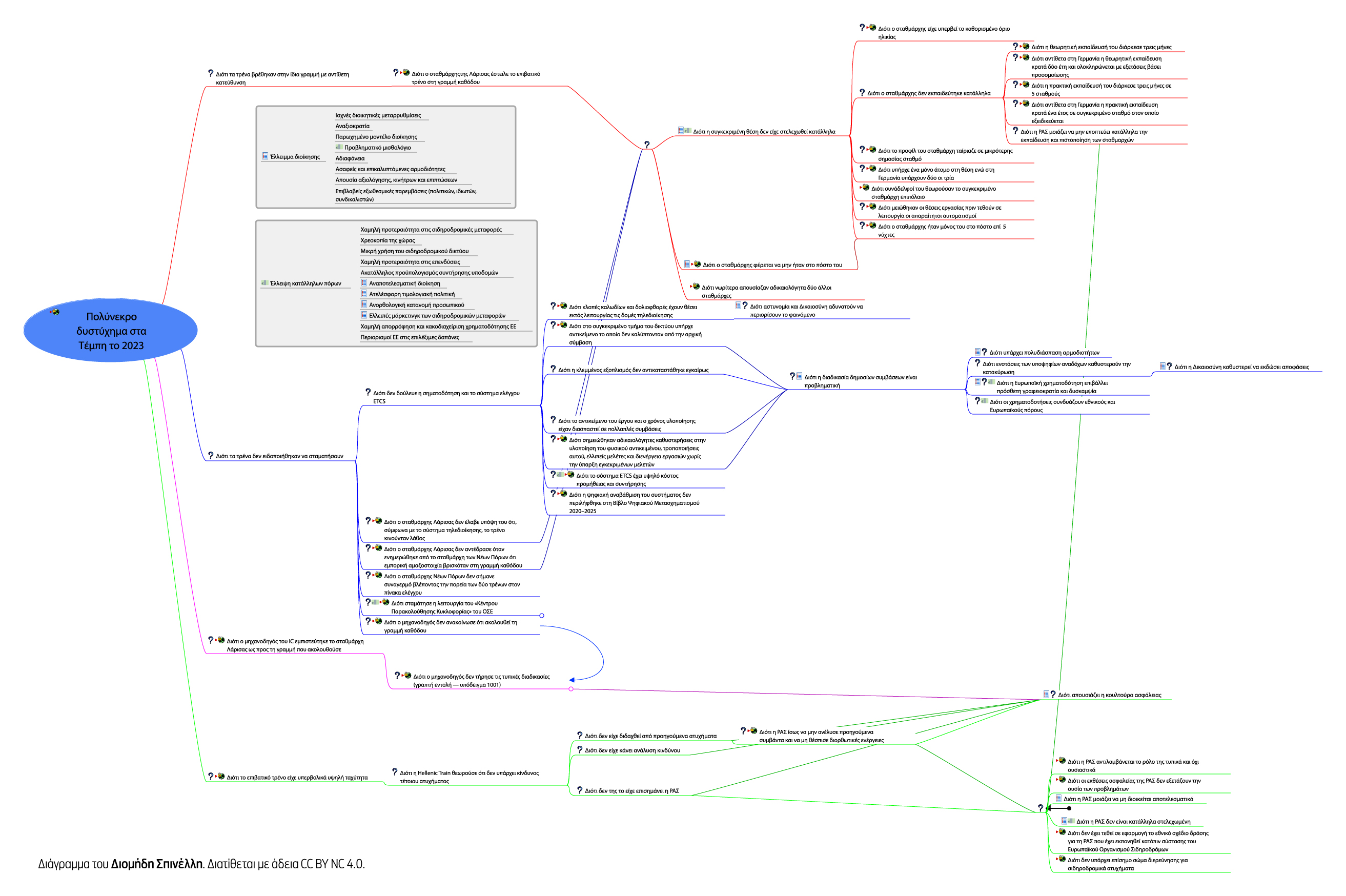
Eight days after a terrible accident Tempe discussing the “why” of the tragedy monopolizes public debate and, of course, people’s emotions. However, according to administrative scholars, discussions in our country after each national tragedy are often conducted erroneously. direction, while it is also short term.
Victims of the accident that claimed the lives of 57 of our fellow citizens, Diomedes Spinellisprofessor in the Department of Administrative Sciences and Technology at the Athens University of Economics and Business, tried, as he writes in a widely read post on Fbook, write down your thoughts about the causes of the accident using the “Five Whys” method in the form of a mental map.
The dense diagram he created is, he says, an attempt to capture the causes of the train accident, which takes the discussion one step further.
Five why method
“I thought yes use V method five why when talking about”WHO guilty” and to whom to attribute them responsibilitiesThe master explains “K”. Spinellis and continues: “At first everyone was talking about the stationmaster. But this was not a productive discussion in the long run, as quickly became apparent. Unfortunately, the personification of the problem after a catastrophe or accident occurs in time. a country us. Dialogue also takes place in the face of opposition. The first thing we always go to is to see who will be held accountable. However, the matter is different. The bottom line is what we can learn and how to avoid repeating mistakes in future. The goal of continual improvement is constantly missing.”
In the Five Whys layout for Tempe, each question mark in it also implies a question about the node that appears to the left of it. The reasoning is as follows: Why do we mourn the death of our 56 brethren at Tempe? Because the trains were on the same line in the opposite direction. Why did the trains travel on the same track in opposite directions? Because the stationmaster sent a passenger train down the line. Why did the stationmaster send a passenger train down the line? Because he didn’t instruct the locksmith to put the key in the right place. Why didn’t he tell the locksmith to put the key in the right place? Because the specific position was not properly staffed, etc.
It is this method, according to the professor, that shows us how we should look for answers by giving us clear directions. “Ask at least five times “why?”, each time we get an answer that us “jumps” to a new question. In fact, there can be at least five questions.Yes and three or seven, depending on each time size and the depth of the problem. whole idea What we don’t stop at the first answer. The method considers briefly, but essentially, in all respects, a complex problem.. OUR the emphasis is on finding the root of the problem.”

Diagram of Diomedes Spinelli. Available under CC BY NC 4.0 license.
A place that systematically works with culture of the five whys, it is aviation that has led to greater safety.
The professor says that this method was first applied Toyota executive director 30 years ago and since then, it is mainly used by university professors as well as large companies. “Essentially, it’s analytical yet concise thinking that helps you get to the root causes without dragging the conversation out unnecessarily,” notes Mr. Spinellis and explains how said method is applied against today at Computer science.
Here he mentions that space, which also works systematically with culture of the five whys air Transport. “It is significant that any problem that an airline finds in its work always reports it, even if it is itself involved in an aviation accident or a plane crash, in order not only to find the “culprit”, but also to improve procedures, training, materials. . This has led us to great safety in aviation,” says the professor.
Key findings from the Tempe accident
Speaking about the main conclusions of the method in the accident at Tempe, Mr. Spinellis mentions first how about next -after to him stationmaster parameter what went into public conversation, it was because of her absence Remote control.
As he explains, citing some of the key findings from the accident: “In the ‘no remote control’ response, we get consistently new responses. Such as an example of what equipment was in some cases stolen and vandalized. But why did this happen? Because the police she’s probably not doing her job properly. We read that they were placed safety to protect equipment. However, it is not possible to provide security on all railway lines. Neither one nor the other justice it also seems that we have helped to limit the phenomenon of vandalism. What justice, until now “responsible” for the fact that the contracts got tangled in her gears and did not move forward.
“In addition, the fact that contracts have been delayed in signing and execution is an issue that affects many sectors of government when it comes to public works. So let’s talk now what about convention 717 the whole Greek problem will be solved Railway, no matter how quickly we implement it, no matter how it sounds, this will not solve the general problem by itself. If we leave her unattended Remote controlI will again stolen again equipment. And then, maybe, a new contract will be needed again, and we will again be “in the air”, because we did not look at the answer to the next “why”.
“Five Whys” tragedy in Tempe
Source: Kathimerini
Ashley Bailey is a talented author and journalist known for her writing on trending topics. Currently working at 247 news reel, she brings readers fresh perspectives on current issues. With her well-researched and thought-provoking articles, she captures the zeitgeist and stays ahead of the latest trends. Ashley’s writing is a must-read for anyone interested in staying up-to-date with the latest developments.